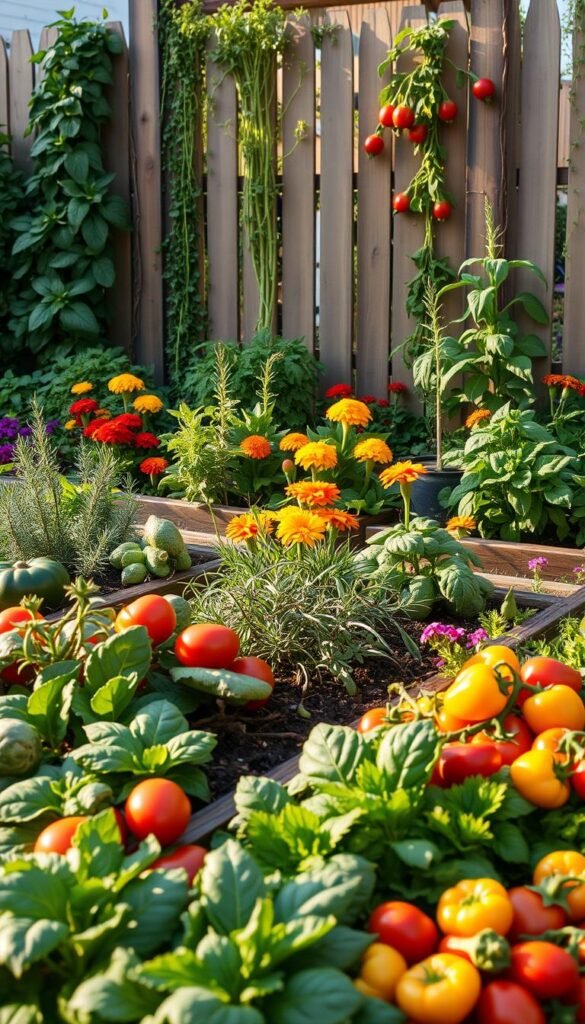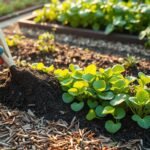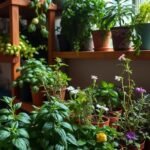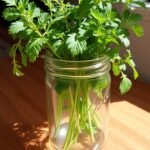What if your most visible outdoor area could do more than just look pretty? Imagine stepping outside your door to harvest fresh ingredients while supporting local wildlife. This vision became reality for one homeowner who swapped their grassy lawn for raised beds bursting with colorful edibles and pollinator-friendly blooms.
Their story proves that functional spaces don’t sacrifice beauty. By adding fruit trees and wildflowers alongside practical crops, they created a living landscape that feeds both people and butterflies. Neighbors now stop to admire the mix of dahlias and veggies, sparking conversations about sustainable living.
You’ll learn how to design productive areas that enhance your home’s character. Discover smart layouts that make watering and harvesting easier while boosting curb appeal. We’ll explore techniques for extending your growing season and choosing plants that thrive in your region.
This approach goes beyond personal benefits—it creates habitats for endangered species like monarch butterflies. Your transformed space can become a neighborhood talking point, showing how aesthetics and ecology work together. Ready to turn underused ground into something extraordinary?
The Benefits of a Front Yard Edible Garden
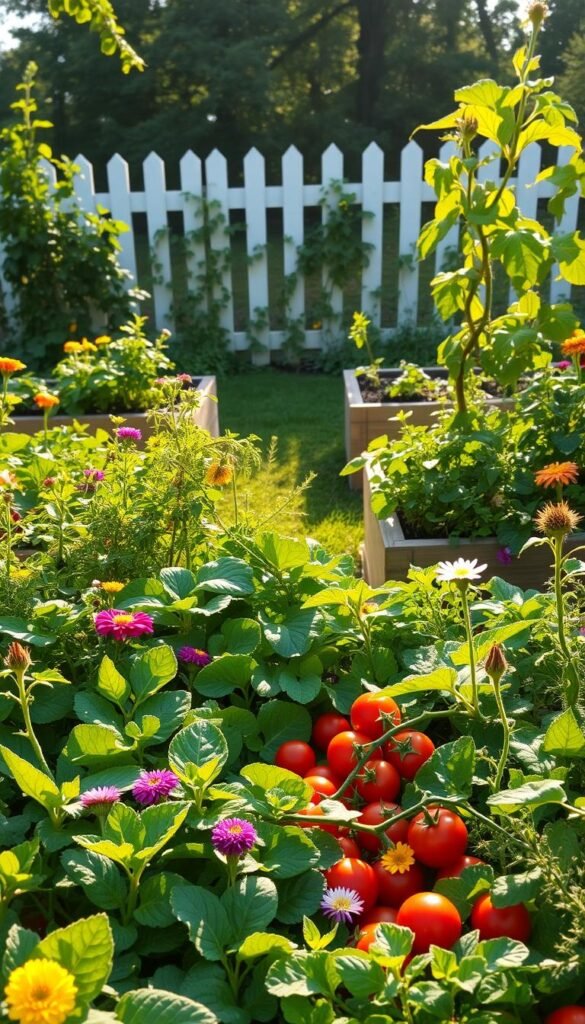
Imagine your home’s exterior nourishing your family and local ecosystems. Swapping turf for productive greenery creates a living bridge between your household and nature’s rhythms. This approach offers unexpected perks beyond fresh ingredients.
Enhancing Home and Community Connection
Your visible growing space becomes a conversation starter. Neighbors often pause to admire berry bushes or ask about unfamiliar herbs. These interactions build bonds while sharing harvest extras like mint or cherry tomatoes.
| Feature | Traditional Lawn | Edible Landscape |
|---|---|---|
| Social Opportunities | Rare interactions | Daily conversations |
| Resource Use | Weekly mowing | Seasonal harvesting |
| Food Production | None | 200+ meals/year* |
*Based on 100 sq ft plantings
Positioning crops near your kitchen simplifies meal prep. No more trekking to the backyard when parsley’s needed mid-recipe. Many find their sunniest spots actually face the street.
Supporting Pollinators and Wildlife
Unlike sterile grass, mixed plantings create habitats. Bees visit blooming basil while birds snack on serviceberries. Even small spaces can host:
- Native wildflowers for butterflies
- Berry shrubs for songbirds
- Herb patches for beneficial insects
This biodiversity strengthens local ecosystems. Your culinary patch becomes part of a larger food web, proving beauty and purpose coexist beautifully.
Planning Your Garden Layout and Design
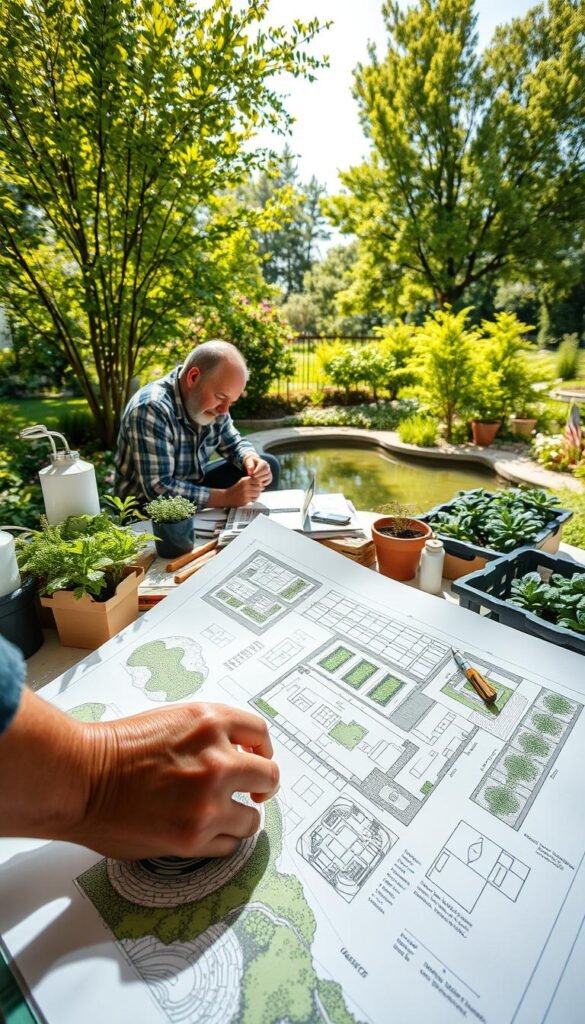
Ever wondered how to turn your outdoor area into a functional yet beautiful space? The secret lies in thoughtful preparation. Successful transformations begin with observation – notice how sunlight dances across your plot throughout the day.
Finding Creative Sparks
Start by exploring your community. Local growers often showcase clever solutions for small areas. Snap photos of appealing arrangements or ask about their favorite plants. Digital tools like Pinterest boards help organize ideas visually.
| Planning Approach | Time Investment | Flexibility |
|---|---|---|
| Quick Start | 2-4 hours | Limited |
| Strategic Design | 10+ hours | High |
| Collaborative Process | 6-8 hours | Moderate |
Mapping Your Vision
Grab graph paper or use free design apps. Mark existing trees, pathways, and sunny patches. Color-code zones for:
- Herb spirals near walkways
- Berry bushes along fences
- Seasonal flowers by seating areas
Leave room for changes – your needs will evolve. One urban gardener revised their layout three times before finding the perfect balance between beauty and productivity. “The magic happens when you let the space guide you,” they shared.
Regularly revisit your plan as seasons change. What works in spring might need adjustment by fall. This living document grows with your experience and shifting priorities.
Front Yard Garden Vegetable Beds: Stylish Ways to Showcase Edibles
Have you considered your property’s prime real estate as both nourishing and eye-catching? Thoughtful arrangements transform ordinary plots into living art galleries where form meets function. Start by grouping plants with contrasting shapes – try feathery carrots beside ruffled kale or upright peppers flanking trailing nasturtiums.
Color coordination works wonders. Pair golden zucchini blossoms with violet basil flowers, or let ruby-hued lettuce frame sunny marigolds. Many food plants offer multiple seasons of interest:
- Bronze fennel’s lacy winter seed heads
- Rainbow chard’s jewel-toned stems
- Artichoke’s architectural summer blooms
| Design Element | Ornamental Plants | Edible Alternatives |
|---|---|---|
| Vertical Interest | Clematis vines | Pole beans or malabar spinach |
| Ground Cover | Creeping thyme | Alpine strawberries |
| Focal Points | Hydrangea bushes | Blueberry shrubs |
Smart layouts maintain accessibility without sacrificing style. Curved pathways between beds create inviting flow, while staggered planting heights guide the eye naturally. One creative grower alternates rosemary hedges with pepper plants, achieving both structure and snackability.
Seasonal rotations keep displays fresh. Swap cool-weather mustard greens for warm-season okra, ensuring continuous visual appeal. Remember: edible doesn’t mean ordinary – with smart pairings, your plot becomes a living masterpiece that nourishes body and soul.
Choosing the Right Raised Beds and Materials
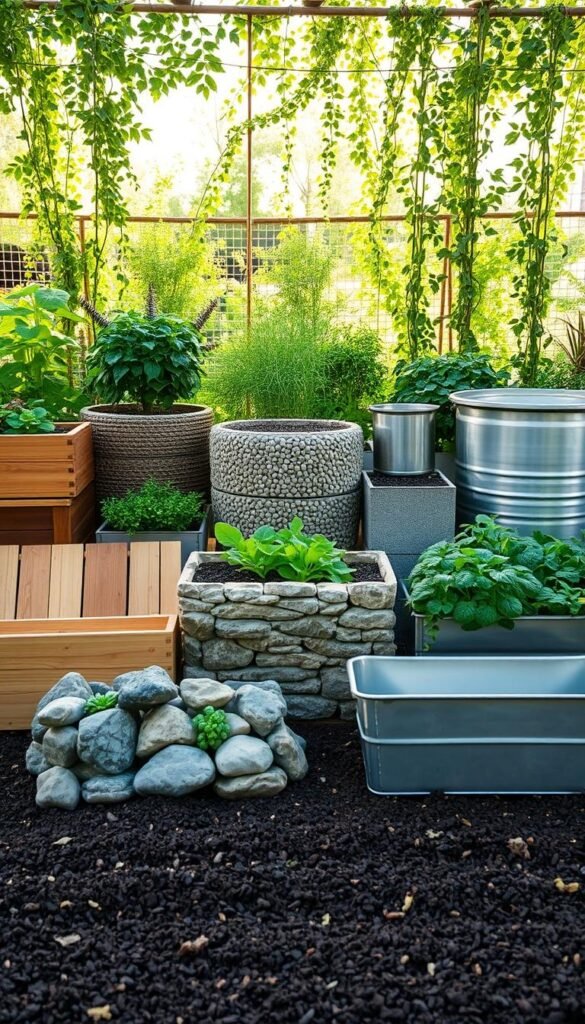
Your growing space deserves a foundation that works as hard as you do. Material choices impact both plant health and visual harmony, turning functional elements into design features. Let’s explore options that balance practicality with personality.
Exploring Wood, Metal, and Repurposed Options
Natural wood offers warmth and affordability. Redwood and cedar resist rot naturally, lasting 5-7 years untreated. Metal beds bring modern flair and durability – galvanized steel outlasts most materials. For budget-conscious growers, repurposed items like old fence boards or livestock troughs add character.
| Material | Cost | Lifespan | Eco-Friendliness |
|---|---|---|---|
| Redwood | $$ | 7-10 years | High |
| Galvanized Steel | $$$ | 15+ years | Medium |
| Repurposed Items | $ | Varies | Highest |
Preparing Soil with Landscape Fabric and Cardboard
Grass sneaks into shallow beds like uninvited guests. Prevent invasions with smart layering:
- Cardboard first – smothers weeds while feeding earthworms
- Landscape fabric next – blocks persistent roots
- Soil mix last – 60% topsoil, 30% compost, 10% sand
Beds under 24″ tall often struggle with grass. One gardener learned this the hard way: “My 12-inch beds became weed hotels within months. Going taller saved my harvest!” Depth matters for root development too – tomatoes and carrots thrive in deeper setups.
Combining materials creates visual rhythm. Try pairing rustic wood beds with sleek metal planters near walkways. For those starting small, budget-friendly raised beds using salvaged materials prove beauty doesn’t require big investments.
Seasonal Planting for Year-Round Harvest
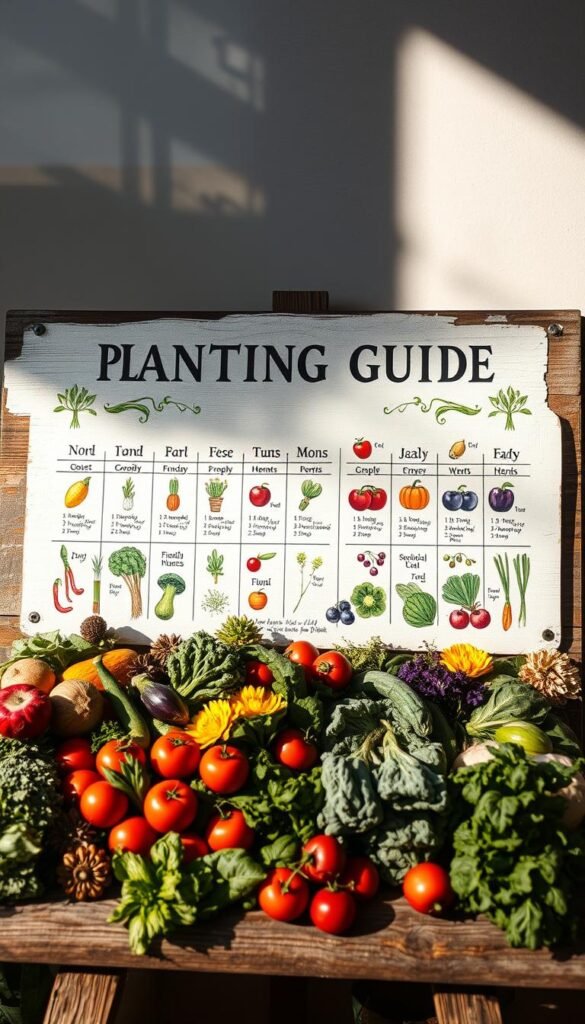
What keeps your plot productive when others go dormant? Smart timing turns your space into a living calendar that cycles through flavors and colors. Let’s explore how to match nature’s rhythm for non-stop harvests.
Selecting Vegetables, Herbs, and Flowers for Every Season
Rotate crops like a pro chef changes menus. Cool-weather stars like crisp lettuce and sweet peas thrive in winter’s chill. When summer heat arrives, swap them for heat-lovers like zucchini and cucumbers that bask in sunshine.
| Season | Vegetables | Herbs | Flowers |
|---|---|---|---|
| Winter | Carrots, Beets | Parsley, Cilantro | Pansies, Snapdragons |
| Spring | Peas, Broccoli | Dill, Chives | Calendula, Nasturtiums |
| Summer | Beans, Peppers | Basil, Oregano | Marigolds, Zinnias |
| Fall | Kale, Radishes | Sage, Thyme | Mums, Asters |
Overlap plantings for seamless transitions. Sow quick-growing radishes between slower cabbage plants. One gardener shares: “My blueberry bushes give winter structure, while summer beans climb their branches like living trellises.”
Adapting Your Garden to Local Conditions
Your zip code dictates planting dates more than any calendar. Connect with nearby nurseries – their experts know which varieties handle your area’s frost dates and soil quirks. Many offer free classes on microclimate tricks.
Try these zone-smart strategies:
- Use row covers to extend cold-season growing
- Plant heat-tolerant herbs like rosemary in southern zones
- Choose bolt-resistant lettuce varieties for humid regions
Remember: successful plots mirror local ecosystems. A Midwest grower pairs native coneflowers with tomatoes, creating pollinator pit stops. Your regional adaptations become the garden’s secret sauce.
Watering Strategies and Irrigation Techniques
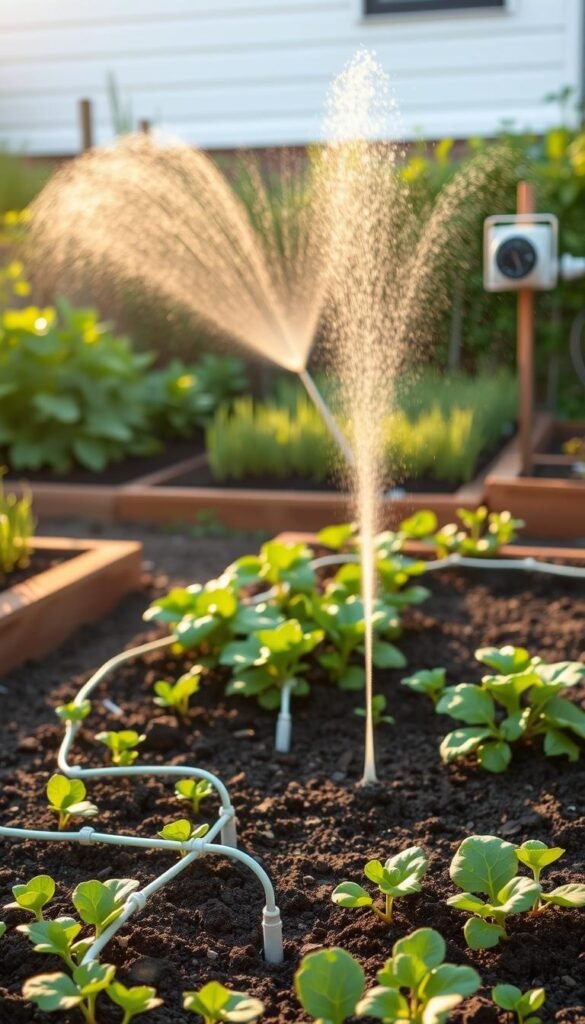
How does your outdoor space stay lush without constant attention? Smart hydration methods keep plants thriving while freeing up your schedule. Let’s explore systems that work smarter, not harder.
Implementing Drip Irrigation and Ollas
Modern drip systems deliver moisture straight to roots through tiny tubes. Connect them to existing sprinkler lines for automated care. One gardener reported: “My water bill dropped 40% after switching – the plants actually look healthier!”
| Method | Water Savings | Maintenance Time |
|---|---|---|
| Drip System | 50-70% | 30 mins/month |
| Ollas | 60% | 15 mins/week |
| Hand Watering | 20% | 2-4 hours/week |
Ancient olla techniques still shine today. Bury unglazed clay pots near crops – they slowly release water as soil dries. Perfect for vacation weeks or drought-prone areas.
Don’t ditch the watering can completely. Regular check-ins let you spot pests early. Many find this quiet time becomes their favorite part of the day. Rotate between methods for best results:
- Automate routine hydration with drip lines
- Use ollas for deep-rooted tomatoes
- Hand-water container plants for precision
Combine approaches based on plant needs. Heat-loving peppers might need daily drinks in July, while established herbs prefer weekly soakings. For more conservation ideas, explore water-saving strategies that protect resources.
Designing Edible Landscapes with Creative Bedding Plants
Why choose between beauty and bounty when your landscape can deliver both? Strategic plant selection turns ordinary flower beds into multi-purpose spaces that nourish and delight. Let’s explore how to blend aesthetics with practicality using vegetation that works double-duty.
Incorporating Edible Bedding Plant Ideas
Swap traditional annuals with flavorful alternatives that dazzle the eye. Try these showstoppers:
- Rainbow chard – neon stems create living stained glass
- Purple basil – forms fragrant carpets in detailed patterns
- Ornamental eggplant – offers violet blooms and striped fruits
Herb enthusiast Marie Viljoen notes: “Curly parsley makes better border edging than most boxwoods – and you can eat it!” For height, use cardoon’s silvery leaves as dramatic backdrops. These edible garden plants thrive in tight spaces while serving multiple roles.
Balancing Ornamental and Functional Plantings
Create visual harmony with this simple formula:
| Design Role | Edible Option | Visual Benefit |
|---|---|---|
| Ground Cover | Alpine strawberries | Dainty white flowers |
| Focal Point | Artichokes | Architectural foliage |
| Border Edge | Lemon thyme | Golden leaf margins |
Maintain accessibility by leaving 18-inch paths between productive areas. Alternate harvest-ready crops with longer-lasting perennials like rosemary hedges. This approach keeps your space photo-ready while providing kitchen ingredients.
Remember: successful edible designs mirror nature’s layers. Pair tall sunflowers with mid-height peppers and trailing nasturtiums for depth. Your landscape becomes a living pantry that neighbors will envy – and maybe even sample!
Engaging Your Family and Community in Front Yard Gardening
How can your outdoor space become a hub for connection and learning? Visible plantings spark conversations that transcend property lines. One parent shared: “Our kale patch became the neighborhood classroom – kids now point out swallowtail caterpillars like they’re spotting celebrities!”
Growing Bonds Through Shared Efforts
Assign age-appropriate tasks to build ownership. Youngsters love watering with mini-cans or hunting for ripe cherry tomatoes. Create themed zones like a pizza garden with basil and oregano – it turns harvests into interactive meals.
| Activity | Traditional Approach | Community Focus |
|---|---|---|
| Interaction Frequency | Isolated work | Daily exchanges |
| Learning Opportunities | Online research | Hands-on mentoring |
| Resource Sharing | Store-bought tools | Seed swaps & tool libraries |
Neighbors often pause to admire progress. Keep a basket of mint sprigs or sunflower heads by the sidewalk. These small gestures build relationships while showcasing sustainable practices.
Teach composting through bug hotel projects. Kids arrange pinecones and sticks to attract beneficial insects. One grandparent noted: “My granddaughter checks our ‘insect Airbnb’ daily – she’s learned more biology here than in textbooks!”
- Host seasonal seed-starting workshops
- Create plant marker art with recycled materials
- Start a produce exchange box for surplus harvests
Your front yard garden becomes more than a food source. It’s where generations connect over earthworms and where strangers become friends discussing heirloom tomatoes. These shared experiences cultivate deeper roots than any solitary hobby could.
Wrapping Up Your Edible Front Yard Transformation
Your journey toward a productive outdoor space begins with simple steps. Start small by replacing ornamental shrubs with fragrant herbs or vibrant edible flowers. Many find their first season becomes a joyful experiment, revealing which plants thrive in their unique conditions.
Don’t fear imperfections – nature celebrates surprises. That volunteer tomato plant growing through your rosemary? Let it stay. These happy accidents often become garden highlights. Remember: healthy soil fuels success. Test and amend it annually for better harvests.
For those wanting to grow food while boosting curb appeal, edible landscaping ideas offer endless inspiration. Mix everbearing strawberries with flowering perennials, or train grapevines along fences. Your space evolves yearly, reflecting lessons learned and new preferences.
Share extra produce with neighbors – a basket of basil strengthens community bonds. Over time, your plot becomes more than a home garden. It’s a living classroom where kids discover butterflies and adults reconnect with seasonal rhythms. Every seed planted today grows tomorrow’s possibilities.
